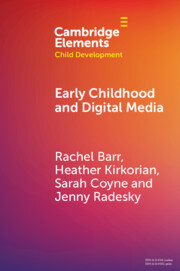Element contents
Early Childhood and Digital Media
Published online by Cambridge University Press: 24 April 2024
Summary
- Type
- Element
- Information
- Series: Elements in Child DevelopmentOnline ISBN: 9781108885751Publisher: Cambridge University PressPrint publication: 23 May 2024
References
- 15
- Cited by

